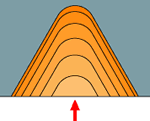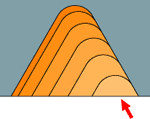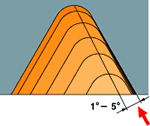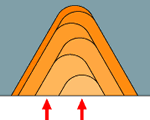| |
Features |
| Advantages |
Disadvantages |

Radial Infeed |
- Easiest to use. (Standard programme for threading)
- Wide application. (Cutting conditions easy to change.)
- Uniform wear of the right and left sides of the cutting edge.
|
- Difficult chip control.
- Subject to vibration in the later in stages of cutting.
- Ineffective for large pitch threading.
- Heavy load on the nose radius.
|

Flank Infeed |
- Relatively easy to use. (Semi-standard programme for threading.)
- Reduced cutting force.
- Suitable for large pitch threads or materials that peel easily.
- Good chip discharge.
|
- Large flank wear on the right side of the cutting edge.
- Relatively difficult to change cutting depth. (Re-programming necessary)
|

Modified Flank Infeed |
- Preventing flank wear on the right side of the cutting edge.
- Reduced cutting force.
- Suitable for large pitch threads or materials that peel easily.
- Good chip discharge.
|
- Complex machining programming.
- Difficult to change cutting depth. (Re-programming necessary)
|

Incremental Infeed |
- Uniform flank wear of the right and left sides of the cutting edge.
- Reduced cutting force.
- Suitable for large pitch threads or materials that peel easily.
|
- Complex machining programming.
- Difficult to change cutting depth. (Re-programming necessary)
- Difficult chip control.
|









